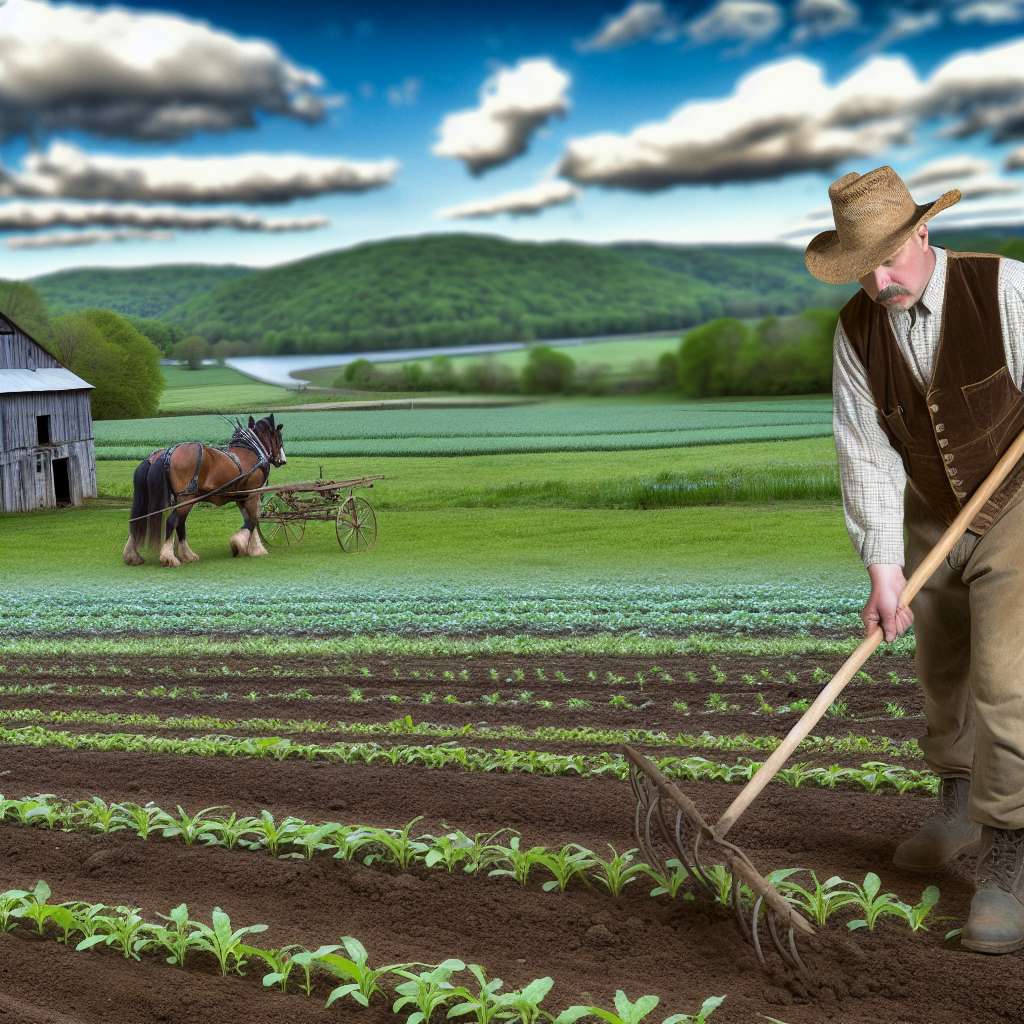Introduction to Crop Rotation and Its Importance for Sustainable Agriculture
Crop rotation involves changing the type of crop grown in a particular area over time.
This practice plays a crucial role in sustainable agriculture.
Farmers use it to enhance soil health and fertility.
Additionally, crop rotation helps control pests and diseases effectively.
By varying crops, farmers can reduce the risk of crop failure.
Moreover, this technique promotes biodiversity on farms.
Different crops have varying nutrient requirements.
Rotating crops allows the soil to recover and maintain its fertility.
As such, crop rotation minimizes the need for chemical fertilizers.
This practice also mitigates soil erosion and enhances soil structure.
Furthermore, it helps in managing weeds organically.
The timing of crop rotation is essential for maximizing its benefits.
Farmers must plan carefully to align with growing seasons.
Effective rotation schedules can vary regionally based on local conditions.
For instance, legumes can fix nitrogen in the soil, benefiting subsequent crops.
Transform Your Agribusiness
Unlock your farm's potential with expert advice tailored to your needs. Get actionable steps that drive real results.
Get StartedBeneficial microorganisms in the soil also thrive with diverse cropping systems.
Crop rotation is a fundamental practice in sustainable agriculture.
It fosters resilience in farming systems against climate change and market fluctuations.
Benefits of Crop Rotation
Soil Health
Crop rotation enhances soil health significantly.
It helps maintain nutrient levels in the soil.
Different crops contribute varying nutrients to the soil.
This method reduces soil erosion effectively.
Moreover, it encourages the development of beneficial microorganisms.
These microorganisms improve soil structure and fertility.
As a result, crop rotation leads to increased organic matter in the soil.
Pest Management
Effective pest management is another key benefit of crop rotation.
Changing crops disrupts pest life cycles.
This makes it harder for pests to thrive and reproduce.
Additionally, certain crops can deter specific pests.
This reduces the need for chemical pesticides.
Furthermore, crop diversity lowers the risk of disease spread.
Pests often prefer specific host plants, which crop rotation mitigates.
Yield Improvement
Yield improvement is a significant advantage of crop rotation.
Rotating crops can lead to better overall yields.
Different crops utilize soil nutrients differently.
As a result, successive crops can access untapped nutrients.
This practice also helps prevent crop fatigue.
Crop rotation can increase marketable produce, directly benefiting farmers.
With higher yields, profitability in sustainable farming rises.
Showcase Your Farming Business
Publish your professional farming services profile on our blog for a one-time fee of $200 and reach a dedicated audience of farmers and agribusiness owners.
Publish Your ProfileKey Principles of Effective Crop Rotation Techniques
Understanding Crop Rotation
Crop rotation involves alternating the types of crops grown in a particular area.
This method improves soil health and reduces pest populations.
Additionally, it helps prevent nutrient depletion in the soil.
Enhancing Soil Fertility
Diverse crops contribute different nutrients to the soil.
For instance, legumes fix nitrogen, which enriches the soil.
Moreover, deep-rooted plants can access nutrients unavailable to shallow-rooted crops.
Pest and Disease Management
Crop rotation disrupts pest and disease life cycles.
Certain pests thrive on specific crops, so changing crops reduces their populations.
Consequently, farmers experience fewer pest-related issues over time.
Improving Yield Consistency
By rotating crops, farmers can achieve more consistent yields.
This practice minimizes the risk of crop failure due to factors like disease.
Therefore, farmers can rely on a diverse planting strategy to maintain productivity.
Increasing Biodiversity
Crop rotation promotes biodiversity in farming ecosystems.
This biodiversity supports a wider range of beneficial organisms.
As a result, the overall health and resilience of the agricultural system improve.
Planning and Implementation
Effective crop rotation requires careful planning and implementation.
Farmers should analyze their specific soil types and climate conditions.
Additionally, they should choose crops based on market demands and growth patterns.
Creating a rotation schedule helps ensure optimal soil and crop health.
Uncover the Details: Financial Analysis Tools Every Farmer Should Utilize For Success
Specific Crop Rotation Examples: Legumes, Grains, and Cover Crops
Legume Crop Rotation
Legumes are vital for enhancing soil nitrogen levels.
They can be grown in rotation with cereals for optimal results.
Common legumes include clover, peas, and beans.
Growing legumes improves soil fertility and structure.
This practice reduces the need for chemical fertilizers.
Incorporating legumes also interrupts pest and disease cycles.
Farmers can alternate between legumes and grains effectively.
Grain Crop Rotation
Grain crops like corn and wheat thrive in rotational systems.
Rotating grains enhances yield and reduces soil erosion.
For instance, planting corn followed by wheat is a common practice.
These crops utilize different soil nutrients efficiently.
Furthermore, grain rotation helps manage weeds more effectively.
Employing various types of grain enhances farm diversity.
This approach leads to improved overall soil health.
Cover Crop Benefits
Cover crops are crucial for preventing soil erosion.
They provide ground cover during off-seasons between main crops.
Common cover crops include rye, radish, and vetch.
These crops help retain soil moisture and improve soil structure.
Additionally, they suppress weed growth effectively.
Using cover crops enhances biodiversity on the farm.
Showcase Your Farming Business
Publish your professional farming services profile on our blog for a one-time fee of $200 and reach a dedicated audience of farmers and agribusiness owners.
Publish Your ProfileFarmers should integrate cover crops into their rotation plans.
Implementing Crop Rotations
Effective crop rotation requires planning and knowledge.
Farmers must evaluate their soil and local conditions.
Additionally, they can consult with agronomists for tailored advice.
Regular monitoring of crop performance is essential.
Adjustments may be necessary based on specific outcomes.
Over time, these practices contribute to sustainable farming systems.
Ultimately, informed crop rotation leads to productive and resilient farms.
Delve into the Subject: Pricing Models To Maximize Revenue In Agritourism Offerings
Integrating Crop Rotation with Other Sustainable Practices
Organic Farming
Organic farming enhances the benefits of crop rotation.
It promotes soil health through natural processes.
This practice reduces reliance on synthetic fertilizers.
Farmers use organic matter to enrich the soil.
Cover crops play a vital role in this system.
They improve soil structure and fertility.
Incorporating diverse crops also controls pests naturally.
Crop rotation combined with organic methods leads to sustainability.
No-Till Agriculture
No-till agriculture complements crop rotation effectively.
This practice minimizes soil disturbance.
It helps maintain soil structure and moisture levels.
Farmers plant cover crops to protect the soil year-round.
These cover crops suppress weeds naturally.
Furthermore, they enhance nutrient cycling and biodiversity.
By combining no-till practices with rotation, farmers boost yields.
This method ultimately contributes to long-term soil health.
Agroforestry
Agroforestry integrates trees with crop rotation systems.
This approach enhances biodiversity on agricultural land.
It provides shade, reducing heat stress on crops.
Tree roots improve soil structure and prevent erosion.
Additionally, agroforestry systems can produce multiple outputs.
Farmers benefit from both crops and tree products.
This integration supports ecological resilience and sustainability.
Moreover, it encourages a varied habitat for wildlife.
See Related Content: Water Conservation Techniques to Enhance Farm Sustainability

Challenges and Considerations in Implementing Crop Rotation Systems
Understanding Common Challenges
Farmers frequently encounter various challenges when implementing crop rotation.
Daily operations may become more complex due to planning and management needs.
Moreover, not all crops may thrive in rotation systems.
Specific climate conditions can hinder the successful growth of certain crops.
Additionally, soil health and structure must be adequately managed.
Financial Considerations
Investing in crop rotation can involve significant upfront costs.
Showcase Your Farming Business
Publish your professional farming services profile on our blog for a one-time fee of $200 and reach a dedicated audience of farmers and agribusiness owners.
Publish Your ProfileFarmers may need to purchase new seeds or equipment for different crops.
Transitioning to a new system may also reduce yield in the short term.
Nonetheless, long-term benefits can outweigh these initial financial hurdles.
Knowledge and Skills Requirements
Implementing effective crop rotation demands a strong understanding of agronomy.
Farmers should learn about the best practices for various crops.
Training may involve workshops, online courses, or mentorship programs.
Additionally, staying updated on agricultural research is crucial.
Dealing with Pest and Disease Management
Crop rotation can help manage pests and diseases, but challenges remain.
Some pests may adapt to different crop types over time.
Vigilant monitoring is essential for successful pest management.
Farmers should develop strategies for preventing pest resistance.
Coordinating with Agricultural Policies
Government policies can influence the success of crop rotation systems.
Subsidies may not cover all costs associated with new practices.
Farmers should be aware of local regulations regarding crop rotation.
Collaboration with agricultural organizations can yield beneficial insights.
Engaging with the Community
Community support can enhance the success of crop rotation systems.
Farmers should consider forming local networks to share knowledge.
Participating in community events can foster collaboration and innovation.
Such engagement may also offer resources and advice from experienced farmers.
See Related Content: Enhancing Soil Health with Diversified Farming Practices
Case Studies: Successful Crop Rotation Practices from Around the World
Crop Rotation in the Netherlands
The Dutch farmers apply diverse crop rotation techniques.
They combine potatoes, carrots, and onions efficiently.
This method enhances soil nutrients and decreases pests.
For example, the Van der Meer family reports increased yields.
They use precision agriculture to monitor crop health.
Strategies in Australia
In Australia, farmers implement a rotation of legumes and cereals.
This shift improves soil fertility naturally.
Farmers such as the Green family have adopted these practices.
They also integrate fallow periods to control water use.
This approach has reduced drought impacts significantly.
Techniques from Canada
Canadian farmers utilize a diverse rotation strategy as well.
They often rotate canola with wheat and barley.
This method helps manage weeds more effectively.
Research by the Prairie Agricultural Research Institute shows promising results.
Yields have improved while using fewer herbicides.
Innovations in Brazil
In Brazil, farmers have pioneered soil conservation practices.
They introduce corn and soybean rotations alongside cover crops.
This system enhances both soil quality and crop resilience.
Farmers like Ana Oliveira see significant economic benefits.
Their methods promote sustainable farming in the region.
Showcase Your Farming Business
Publish your professional farming services profile on our blog for a one-time fee of $200 and reach a dedicated audience of farmers and agribusiness owners.
Publish Your ProfileIntegrative Approaches in Madagascar
Madagascar showcases traditional practices combined with modern techniques.
Farmers rotate rice with legumes and vegetables, enhancing biodiversity.
This approach increases food security for local communities.
Collaborative projects have helped share successful strategies.
As a result, the agricultural sector experiences revitalization.
Future Trends in Crop Rotation
Integration of Technology
Technology plays a vital role in modernizing crop rotation practices.
Farmers are using precision agriculture tools to enhance efficiency.
Drones and satellites monitor crop health and soil conditions.
Farm management software helps in planning rotations based on data.
Moreover, sensors provide real-time feedback to optimize decisions.
Research and Development Initiatives
Ongoing research focuses on resilient crop varieties.
Scientists aim to develop crops that withstand climate variability.
Studies also explore the benefits of diverse crop systems.
Collaborative efforts encourage sharing successful rotation strategies.
Public and private sectors invest heavily in agricultural innovation.
Adaptation to Climate Change
Climate change significantly impacts traditional farming practices.
Farmers are adapting crop rotations to shifting weather patterns.
Diverse crops can improve soil structure and reduce erosion.
Rotating crops mitigates disease and pest pressures effectively.
Additionally, cover crops enhance soil fertility and moisture retention.
Emphasizing Sustainability
Sustainable practices are gaining importance in crop rotation.
Farmers are increasingly adopting organic and regenerative methods.
These practices enhance biodiversity and promote soil health.
Furthermore, such approaches reduce dependency on chemical inputs.
As a result, sustainable farming contributes to food security.
Additional Resources
What is Sustainable Agriculture? | Union of Concerned Scientists
Long-Term Evidence Shows that Crop-Rotation Diversification …




